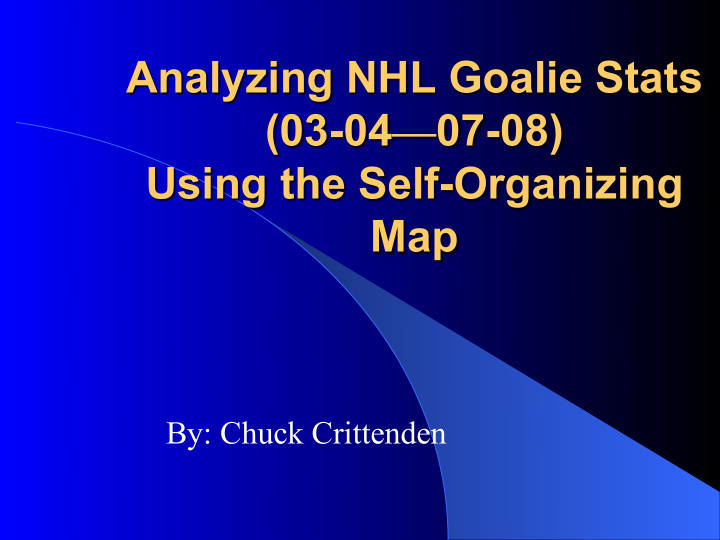



Analyzing NHL Goalie Stats (03-04 — 07-08) Using the Self-Organizing Map By: Chuck Crittenden
"In hockey, goaltending is 75 percent of the game. Unless it's bad goaltending. Then it's 100 percent of the game, because you're going to lose." ~ Gene Ubriaco (NHL forward)
Overview l Problem l Hypothesis l Data l Self-Organizing Map l Resulting Map l Conclusion
The Problem l NHL Goaltending Statistics by Team – (03-04 through 07-08) l Average Standings for each Team l Use Self-Organizing Map – Find natural clusters
Problem cont. l Stats – GAA, SV %, DIFF l Standings and Levels
The Hypothesis l Goaltending – Last Line of Defense l Levels will appear in the Resulting Map l Including DIFF
The Data
Data l GAA – Goals Against Average Goals Allowed ` Number of Minutes Played(1/60) l SV% – Save Percentage Goals Allowed Shots Allowed l DIFF – Goal Differential DIFF = Goals Scored – Goals Allowed
The Algorithm l Self-Organizing Map (SOM) – Artifical Neural Network l Clusters in 2-dimensional map
What is Needed? l A .bat file containing the reference to the executables and the specifics of the map. l The executables randomly initialize, run the algorithm, and calibrate the label onto the points. l som_mapper.exe
Initial Map l Randomly intialized. l Each team (p) compared to each point on the map (q) with Euclidean distance. l Whichever point the specific team is closest to. l That point is trained accordingly. l Other points around it are also trained, just not as much.
SOM l Process repeats for a set number of times. l The labels are pasted on to each instance. l The Map is made.
The Result l 15x15 Map
Result l Layers l Columbus l Levels l Big Names l Overlaps l Effect of Lockout l Corners
Standings
Conclusion l Able to cluster levels l Extreme teams in corners l DIFF makes a difference l Goaltending makes a difference.
"In hockey, goaltending is 75 percent of the game. Unless it's bad goaltending. Then it's 100 percent of the game, because you're going to lose." ~ Gene Ubriaco (NHL forward)
Summary l Problem l Hypothesis l Data l Self-Organizing Map l Resulting Map l Conclusion
Sources Aleshunas, John. Retrieved Apr. 17, 2008. “ Self-Organizing Map (SOM) ” from: http://mercury.webster.edu/aleshunas/MATH%203210/MATH%203210%20Source%20Code%20and%20Executables.html Goaltender ’ s Annex. Retrieved May 5, 2008. Ubriaco Quote from: http://www.angelfire.com/sk/goalieannex/quotes02.html NHL.com. Retrieved Apr. 16, 2008. “ Goalie Statistics and Team Standings ” from: http://www.nhl.com/nhlstats/app Yahoo Sports. Retrieved Apr. 16, 2008. “ Goalie Statistics and Team Standings ” from: http://sports.yahoo.com/nhl/teams/___/stats (Replace ___ with each team ’ s abbreviation). Wikipedia. Retrieved Apr. 17 2008. “ Stepping through the Algorithm ” from: http://en.wikipedia.org/wiki/Self-organizing_map - Stepping_through_the_algorithm Wikipedia. Retrieved May 1, 2008. “ List of Stanley Cup Champions ” from: http://en.wikipedia.org/wiki/List_of_Stanley_Cup_champions#NHL_champion Wikipedia. Retrieved May 6, 2008. “ Euclidean Distance ” from: http://en.wikipedia.org/wiki/Euclidean_distance
Recommend
More recommend